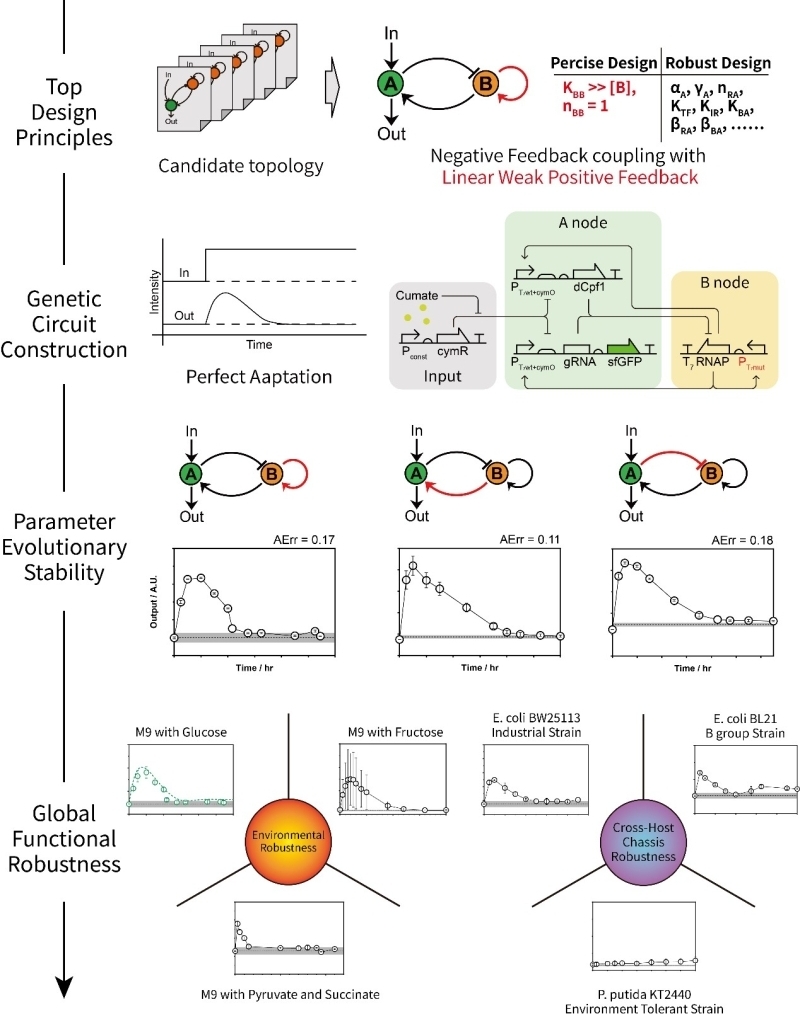Researcher Develop New Synthetic Genetic Circuits for Prefect Adaptation Function
Date:04-03-2022 | 【Print】 【close】
Since the sophisticated genetic circuits can be very subtle, external environmental variability and host evolutionary instability have emerged as key factors impeding the predictable design of genetic circuit functions in the field of synthetic biology, which remains a major challenge.
Recently, LOU Chunbo's group at the Shenzhen Institute of Advanced Technology (SIAT) of the Chinese Academy of Sciences (CAS), along with other collaborators: TANG Chao at Peking University and YU Bo's group at the Institute of Microbiology of the CAS, published their research results entitled "Synthetic robust perfect adaptation achieved by negative feedback coupling with linear weak positive feedback" in the Nucleic Acids Research on Feb. 28.
Theoretically, increasing the redundancy and robustness of the network topology allows the genetic circuits to withstand changes in external parameters, but also leads to too complex inter-regulation of the genetic circuits to be experimentally built. Thus, balancing theoretical robustness and experimental tractability is a higher-level challenge for genetic circuits to perform predefined functions in complex environments.
To address these issues, the team have proposed an ingenious design solution that combined precise experimental design for the key parameters that can be measured precisely and robust design for the majority of other variable parameters, this new design concept is known as the "precise-robustness" design principle.
"Taking the example of a cell expressing a perfect adaptation function, we designed a novel topological network - two nodes with negative feedback coupled to positive feedback at the buffer node," said YU Bo, "the key parameters to be designed precisely are the activation strength of positive feedback at B node satisfying the [B]<<KBB and the self-activating Hill coefficient of 1."
The parameters to be designed robustly are most of the other parameters can be taken at arbitrary values within biologically meaningful intervals. Theoretically, a genetic circuit satisfying such topology and parameter constraints should be able to perform perfect adaptation functions robustly.
The team achieved a one-time success in building and executing the adaptive function without any trial-and-error process, and a perfect adaptation function at that. To test the robustness of other parameters, all regulatory relationships of the topology were subjected to genetic mutation perturbation and they were found to still perform the adaptive function perfectly. Furthermore, the team found that this genetic circuit could then perform functions under different environmental culture conditions. Surprisingly, the same genetic circuit and the same functional sequence could be transferred from the model strain of E. coli to industrial strains and to other strains, such as Pseudomonas, with perfect adaptation function. These experimental results demonstrate the environmental robustness and chassis robustness of this genetic circuit.
"In fact, our group systematically described the method of topological network exhaustion and established a universal theory of the "topology-function" relationship of gene regulatory networks in Cell, 2009." said TANG Chao
The precision and robustness principle proposed in this study is based on the above fundamental theory and fully integrated with the constraints obtained in biological practice, which enables the predictable design and construction of genetic circuit functions under the conditions of environmental variability and host evolutionary instability, solving the current "why and how" dilemma in the field of genetic circuit design, and provided a theoretical design basis for guiding the design of genetic circuits in practical applications.
"This study addresses the serious problems of poor stability, functional fragility and susceptibility to interference of synthetic genetic circuits in synthetic biology, and proposes the principle of "precise-robustness" design of functional genetic circuits," said LOU Chunbo, "It provides a new paradigm for the further development and application of genetic circuit engineering."

Precise-Robustness Design of Functional Genetic Circuits. (Image by SIAT)
Media Contact:
ZHANG Xiaomin
Email:xm.zhang@siat.ac.cn